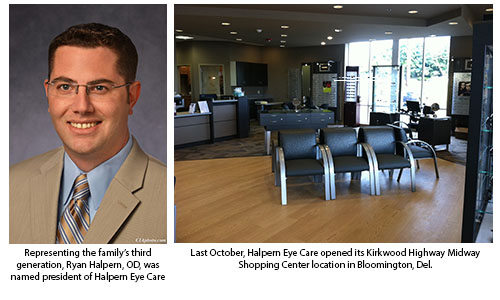DOVER, Del.—
Halpern Eye Care, under the management of the family practice's third generation, Ryan Halpern, OD, has recently implemented strategies to improve patient flow and to take advantage of economies of scale for this nine-location regional group along with the six-location
Vision Associates practice it acquired in Maryland last year.
By enlisting
Practice CoPilot's lean practice management consulting, Halpern Eye Care has kept its schedule full, cut its no-show rate in half, unclogged patient flow, and reduced stress while improving morale among staff and doctors.
Earlier this year, Practice CoPilot spent a week observing Halpern Eye Care's operations, noting roadblocks and bottlenecks in the patient flow process. Ryan Halpern described the process: "They meet with you the first day to lay out goals and concentrate on the area that you want to correct. At that point you can be as interactive as you want," he said, indicating that after that the staff becomes much more involved than company leadership.
After the week of observation, staff members representing the varied positions and locations within the practice were brought together for two days of brainstorming. Practice CoPilot presented their observations, and then the group was divided into small pods tasked with developing solutions for specific problems. "They didn't just tell us what they found and what to do to fix it," said Christy Jones, Halpern's operations manager. "Instead, together we tried to find out the best solutions."
Some of the specific solutions Halpern developed as a direct result of Practice CoPilot's involvement affected the call center. Because their observations revealed that far too much time was being spent on appointment scheduling and duplicating efforts to confirm what insurance coverage certain patients had, they developed a procedure that now ensures all of this information is confirmed long before the day of the appointment. The practice also added two full-time insurance authorization specialists to the centralized Halpern Eye Care call center. Now, insurance is confirmed long before a patient's appointment, eliminating last minute hassles and cancellations. "When the authorization specialists call back, they give patients 24 hours to respond or else get cancelled," said Jones. "We get them off our books rather than leaving them there wondering if they'll show up."
Observations and brainstorming also influenced a change in the way Halpern Eye Care dilates patients, according to Chuck Smith, managing partner of Practice CoPilot. This reduced the doctor's time in the exam room, resulting in a savings of up to five minutes per patient.
Ultimately, after the Halpern team implemented the procedural changes and experienced their results, the way they perceive the practice's overall operations has changed. "They totally changed our way of looking at things. If a problem is occurring among six people in the call center, it's probably the process that's broken. We understand how to look at the process, so now we look at the process first before looking at anything else," said Jones.
While it was through benchmarking that they were able to determine that no-shows were cut from 8.86 percent in March 2013 to 4.89 percent in March 2014, Dr. Halpern pointed out that not all results are measurable. "Some things are just not capable of being benchmarked." These include the overall patient experience and the employees' stress level and sense of morale, he said.
"Those we can feel," added Jones, who agreed with Dr. Halpern that these aspects of running the regional group practice had also improved along with the substantial reduction in no-shows.

Multiple Locations Right from the Start
There wasn't much competition among optometrists in Delaware in 1946 when Ryan Halpern's grandfather, Harold, started the practice. In fact, the state's population was so sparse at the time that he had to launch his practice with multiple locations in towns with populations so small that individually they couldn't support a full-time optometrist. Out of necessity, Halpern Eye Care was a multiple location regional practice right from the start. "Delaware itself has grown over the years, and as the towns grow, we open up offices to deliver access to eyecare," said Ryan Halpern, who joined the family practice as an optometrist in 2007 and became president in 2010.
With the newest office opened in Bloomington, Del., last October, Halpern Eye Care now operates nine locations with a tenth scheduled to open in Georgetown in October. Other recent growth consists of the acquisition of Vision Associates' six locations in Maryland in 2013. While this allows for economies of scale, Halpern describes his business as "corporately managed but independent at heart," meaning that his business philosophy is not just about business. "There's strategy, but you also have to feel good about yourself walking around town," he told dba.
Tracking Patient Flow with RFID Technology
While tracking patient flow was completed manually for Practice CoPilot's analysis of Halpern Eye Care, in the future it can be accomplished using radio-frequency identification (RFID) technology. "We're working on several apps to help track people," said Chuck Smith, managing partner of Practice CoPilot. Using RFID technology, similar to the barcodes used for tracking shipped packages, they will be able to tag doctors, patients and staff and track where anyone is within the practice in real time. The technology can manage and measure how long a staff member takes to perform a task and how long a patient has been waiting. "You want a patient from the front door to optical in less than 42 minutes, otherwise they are less likely to make a purchase," said Smith. This technology can help a practice ensure this by streamlining all the processes that take a patient from the front door to the optical.